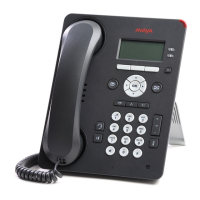value of the SIMULTANEOUS_REGISTRATIONS parameter. Any additional controllers are treated
as alternate registrations. The phone attempts to register using the username and password
provided during the login process. It also uses the SIPDOMAIN parameter. The deskphone uses a
SIP URI unless SRTP is enabled where a SIPS URI is used. When registration is successful, the
phone sets the SIPPROXYSRVR_IN_USE parameter to the IP address of this (Active) Controller.
The phone also performs the other registration tasks.
If the value of the SIPREGPROXYPOLICY parameter is “simultaneous” and a user is logged-in, the
phone attempts and maintains active SIP registrations with all Available Controller(s).
If the value of the FAILBACK_POLICY parameter is “automatic”, the phone's active controller will
always be the highest priority available controller. If the value of the FAILBACK_POLICY parameter
is “admin”, then a controller lower down the priority list may be active.
The phone initiates a search for a new Active Controller whenever one of the following triggers is
encountered:
• Fast Response Timer Expiry,
• TCP keep-alive failure (or other socket error),
• The phone receives an administrative failback trigger,
• An incoming INVITE is received from a non-Active controller,
• A re-registration with the Active Controller times out, or
Whenever one of these triggers is encountered and a user is logged in, the deskphone initiates
parallel REGISTER transactions with every controller in its configured list, including the currently
active controller.
Simultaneous Registration (R6.0 and later SIP software Releases):
For SIP software Release 6.0+, deskphone behavior for simultaneous registration is based on one
of four triggers:
• Trigger 1: The TCP socket closes.
• Trigger 2: A TCP Keep-alive timeout occurs.
• Trigger 3: The deskphone receives an administrative failback trigger from a Configured
Controller.
• Trigger 4: “Fast Response Timer”
Simultaneous registration functions in response to a trigger are:
1. Controller search (maintenance check) - The deskphone tries to establish a connection (if
needed) and then register (or refresh registration) with each of the controllers. If it gets a
successful response to the REGISTER, it marks the controller as “available.” If the
deskphone cannot establish the connection or if it does not receive a successful response, it
marks the controller as “unavailable”.
2. Controller Subscription Refresh - The deskphone sends a refresh SUBSCRIBE to the current
controller for all the subscriptions that it has. If it gets any failure response other than “489
Bad Event” for any of the refresh SUBSCRIBE messages, it removes that subscription and
re-establishes a subscription for that event package.
Controller Determination and Survivability Activity
August 2015 Administering Avaya 9601/9608/9611G/9621G/9641G/9641GS IP Deskphones SIP 129
Comments on this document? infodev@avaya.com

